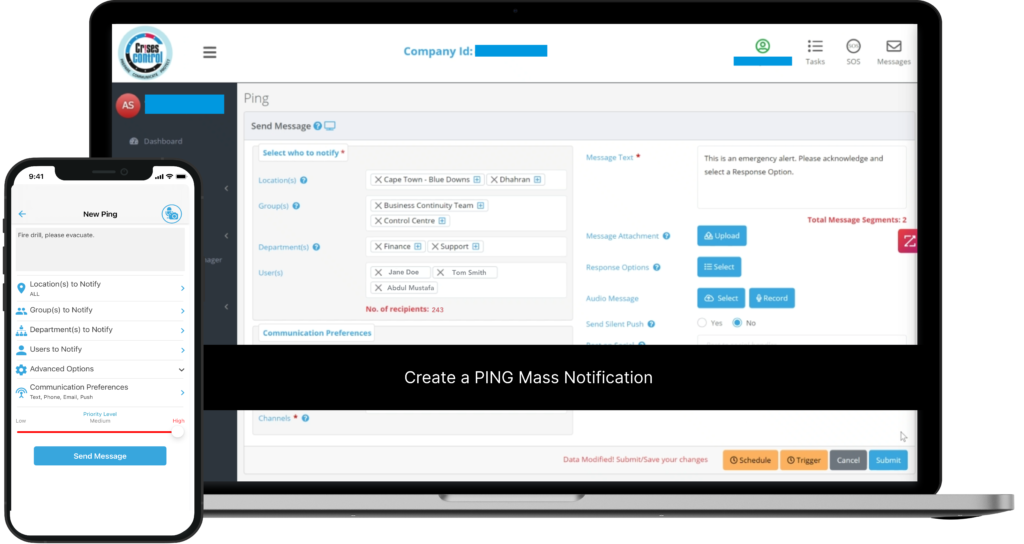Written by Anneri Fourie | Marketing Executive
In an industry as critical and complex as aviation, effective communication during emergencies can mean the difference between swift resolution and potential disaster. As Middle Eastern airports and airlines continue to grow in both scale and complexity, the need for sophisticated mass notification systems has never been more pressing.
This blog explores how advanced mass notification systems can significantly enhance aviation safety in the Middle East and how Crises Control’s solutions can help achieve these goals.
The Critical Need for Mass Notification Systems in Aviation
Aviation safety is a multifaceted challenge, especially in the bustling and diverse aviation sector of the Middle East. The region is known for its high passenger volumes, rapid technological advancements, and unique geographical and environmental conditions. These factors necessitate robust safety protocols and efficient emergency communication systems.
Understanding the Challenges
The aviation sector faces several unique challenges:
- High Passenger Traffic: Middle Eastern airports are among the busiest in the world. Managing communication effectively during an emergency with thousands of passengers is crucial.
- Complex Infrastructure: Airports and airlines in the region often operate with a complex network of terminals, runways, and support services. Coordinated communication is essential to manage such large-scale operations.
- Diverse Environmental Conditions: From sandstorms to extreme heat, environmental factors can complicate emergency response efforts.
- Political Unrest: Recent political unrest in various parts of the Middle East has added another layer of complexity to aviation safety. Unrest can lead to disruptions in operations, increased security risks, and heightened need for rapid, reliable communication to manage and mitigate potential threats.
These multifaceted challenges underscore the importance of having a robust and sophisticated mass notification system in place. Such a system ensures timely and efficient communication, which is crucial for managing emergencies and maintaining safety in a dynamic and often unpredictable environment.
How Mass Notification Systems Improve Aviation Safety
Real-Time Alerts and Communication
One of the primary functions of a mass notification system is to deliver real-time alerts. In aviation, this means promptly notifying airport staff, airline personnel, and passengers of any imminent threats or emergencies. Effective real-time communication ensures that everyone involved can take appropriate action quickly, reducing the risk of confusion and delay.
Coordination Across Multiple Channels
A robust mass notification system supports communication through various channels, including SMS, email, push notifications, and public address systems. This multi-channel approach ensures that messages reach all relevant parties, regardless of their location or access to specific communication tools. For instance, if an emergency occurs, passengers can receive instant updates on their mobile phones, while ground staff can be alerted through radio broadcasts.
Integration with Existing Systems
Advanced mass notification systems are designed to integrate seamlessly with existing airport and airline systems. This integration allows for a unified response to emergencies, leveraging existing infrastructure to enhance overall efficiency. For example, a notification system can be linked with flight management systems to provide automated alerts about delays or cancellations due to unforeseen incidents.
Interested in our Mass Notification Software?
Efficiently alert everyone in seconds at scale with our Mass Notification System – PING, get the message out fast and ensure rapid response and recovery.

Key Features of Effective Mass Notification Systems for Aviation
Scalability and Flexibility
A mass notification system must be scalable to accommodate the varying needs of different airports and airlines. As operations expand, the system should be capable of handling increased volumes of notifications without compromising performance. Flexibility is equally important, as the system should adapt to different types of emergencies and communication needs.
Automated Alerts and Reporting
Automation is a key feature of modern mass notification systems. Automated alerts can be programmed to trigger based on specific criteria, such as the detection of a fire or security breach. Additionally, automated reporting provides detailed insights into the response to each alert, helping organisations assess the effectiveness of their emergency protocols.
User-Friendly Interface
An intuitive user interface is essential for ensuring that the system can be operated efficiently by personnel with varying levels of technical expertise. A user-friendly design simplifies the process of sending notifications and managing responses, allowing staff to focus on handling the emergency rather than navigating complex software.
How Crises Control Can Enhance Aviation Safety
Crises Control offers a cutting-edge mass notification system designed to meet the unique needs of the aviation sector. Our system provides real-time alerts, multi-channel communication, and seamless integration with existing infrastructure. Key features include:
Real-Time Alerts
Crises Control’s system ensures that instant notifications are delivered to all relevant parties during emergencies. This capability is crucial in the aviation sector, where timely information can prevent accidents, manage passenger safety, and streamline emergency responses. Whether it’s a security threat, a natural disaster, or an operational issue, real-time alerts enable quick action, minimising potential disruptions and ensuring that everyone involved is informed promptly.
Multi-Channel Communication
Our Ping mass notification system supports a variety of communication channels, including SMS, email, push notifications, and public address systems. This multi-channel approach ensures that alerts reach all individuals, regardless of their location or preferred communication method. For instance, passengers can receive updates directly on their mobile devices, while airport staff and airline personnel can be alerted through radio broadcasts or internal messaging systems. This versatility helps maintain clear and effective communication during emergencies, enhancing overall coordination and response.
Integration Capabilities
Crises Control’s system is designed to integrate seamlessly with existing airport and airline infrastructure. This compatibility ensures that our mass notification solution works in harmony with current operations, allowing for a unified and efficient response to emergencies. Integration with existing systems—such as flight management, security systems, and operational tools—enables automated alerts and ensures that all relevant data is utilised to manage incidents effectively. This cohesive approach reduces the risk of communication breakdowns and ensures a more organised response.
Reporting and Audit
Our system provides detailed reporting and auditing capabilities, which are essential for evaluating the effectiveness of emergency responses. The reporting feature generates comprehensive records of all alerts sent, including timestamps, recipient details, and response actions. This data is invaluable for analysing the performance of emergency procedures, identifying areas for improvement, and ensuring compliance with safety regulations. Post-incident audits also help refine protocols and enhance overall preparedness for future emergencies.
Incident Management
Crises Control offers robust incident management tools that streamline the process of handling emergencies from start to finish. Our system enables real-time tracking of incidents, coordination of response efforts, and documentation of actions taken. Features such as incident logs, task assignments, and progress tracking ensure that all aspects of the response are managed efficiently. This structured approach helps maintain order during high-pressure situations and facilitates a more effective resolution of emergencies.
Ongoing Training and Support
Effective use of a mass notification system requires not only advanced technology, but also ongoing training and support. Crises Control provides comprehensive training programs to ensure that staff members are proficient in using the system and can respond effectively during emergencies. Additionally, our dedicated support team is available to assist with any technical issues, system updates, or configuration needs. Continuous support and training help ensure that the system remains a reliable and integral part of the organisation’s safety and emergency management strategy.
Global Cloud Location in the Middle East
Crises Control’s Global Cloud Location in the Middle East offers significant advantages for aviation organisations in the region. Our cloud infrastructure is strategically positioned to provide enhanced performance, reliability, and security for our mass notification system. Here’s how our cloud location benefits aviation operations:
- Enhanced Performance and Speed
- Increased Reliability and Uptime
- Enhanced Data Security and Compliance
- Localised Support and Accessibility
Conclusion
In the high-stakes world of aviation, having an advanced mass notification system is essential for ensuring safety and effective crisis management. By implementing a system that offers real-time alerts, multi-channel communication, and seamless integration, aviation organisations in the Middle East can significantly improve their emergency response capabilities.
To learn more about how Crises Control can enhance your aviation safety protocols, request a free personalised demo today. Discover how our innovative solutions can transform your approach to crisis management and ensure a safer, more efficient operation.
Request a FREE Demo

